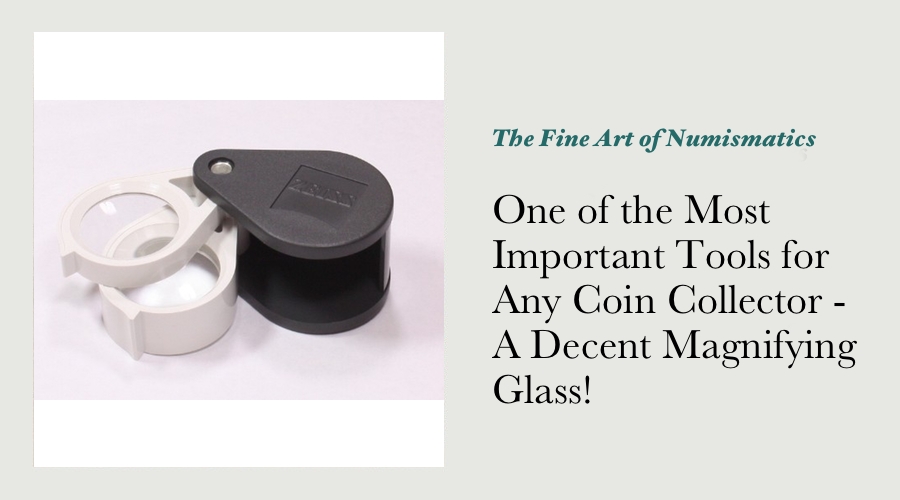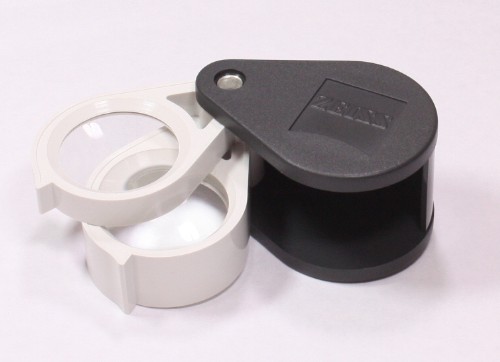One of the Most Important Tools for Any Coin Collector - A Decent Magnifying Glass!

There aren't too many tools that a coin collector needs to indulge themselves, but for anyone that is trading coins where value is a function of quality, a decent magnifier is among the most vital tools in your arsenal.

For those that don't yet appreciate just why or how important a magnifier is to an advanced collector, let's not forget that many coins these days can command prices worth hundreds, if not thousands or tens of thousands of dollars (and much higher of course!) A minor slipup when it comes to authenticating a coin or assessing it's condition can be expensive indeed, which is why it's vital to have suitable tools on hand to help you get the job done - a good quality magnifier allows you to see your potential acquisition up close and personal, allowing you to detect technical characteristics that may alert you to a coin being below par for the grade and asking price, or even worse, to the coin being a counterfeit.
Now there are more types of magnifying glass, magnifiers and loupes available to coin collectors than you could poke a stick at, so the choice on offer can be a little daunting for novice collectors.
Magnifying Glass - Magnifying glasses are generally low-powered, they have a decent-sized handle and a relatively long focal length, so they're extremely easy to use. In practical terms, this means that you can hold a magnifying glass about 25cm away from a coin, and see it at about double normal size. This means that magnifying glasses are easy to use, but they generally aren't strong enough for the purpose they're being used for - to see the fine details of a coin at a sufficient size that you can assess it for condition and authenticity. (Click the link at the start of this paragraph to see images of a wide range of magnifying glasses).
Magnifier - In my opinion, a magnifier is a reasonably generic term used to describe a range of objects that include magnifying glasses, but also other lenses that have slightly different characteristics. Do a google image search for the term "magnifier" (by clicking the link at the start of this paragraph) and you'll see a slightly broader range of objects than just magnifying glasses alone. The term magnifier can mean a lens housed in a stand that sits on your desk; as well as a lens that's part of some rather snazzy headwear; or a lens that's built into a purpose-made frame of some sort. Some magnifiers have higher degrees of magnification than magnifying glasses, and because they're often in a custom frame of some kind, are either a little more difficult to use or are a little more restricted in their use.
Loupe - The dictionaries I've consulted while putting this article together quite clinically state the difference between a loupe and a magnifying glass as being either the absence of a handle, or by the people that use them - jewellers or watch-makers. From what I can see, the term "loupe" is used to describe a smaller than usual magnifier, one that is more powerful than most and often folds into a small cover that protects the lens while it isn't in use. Most loupes will magnify an object (or at least a small portion of it) 6 to 10 times larger than life, which is exactly what most numismatists want to do. Just which kind of handle and just what level of magnification you want will depend on your personal taste - the loupe that I've settled on has a handle that acts as a protective cover (or should that be a protective cover that acts as a handle?), and has two lenses - one with 6 power magnification, the other with 3 power magnification - which means that when they're used together, they offer a total of 9 power magnification, perfect for zooming in on the most minute details of any coin.

So which is the best magnifier for you? A choice of magnifier is a very personal one for any collector - once someone's made a choice they'll defend it in the face of any logic presented to them. It's with that knowledge that I put myself at grave risk of offending a few collectors, and put forward the following suggestions when selecting a magnifier:
1. Don't buy a magnifier that doubles as an article of headwear. For the simple reason that this will make you look like a dead-set kook - a "crazy or eccentric person". While concerns over one's appearance may be a facile reason to not buy a headband with glass lenses in it, allow me to point out that it is rather difficult to negotiate with someone that is laughing at you!
2. Don't buy a magnifier that looks like a prop from the set of the Sherlock Holmes movie. For the simple reason that it won't be powerful enough to do the job you want it to do. Oh, and you'll look like a dead set kook when you use it in polite company.
3. Don't buy a magnifier that has a light in it. I have several colleagues and clients with much expertise and many years of experience that swear by magnifiers that have a small (often daylight balanced) globe that illuminates the subject item. I'm not a big fan of these, not for their kook factor (they in fact look pretty cool), but because I believe they impart a light that impedes the natural observation of the technical characteristics of the coin.
This may or may not be accurate, since the available light in a room at an auction house, trade show or dealer's premises may not be adequate. Light is in fact very important when it comes to viewing coins accurately - garbage in, garbage out. If the room you're looking at your coin in has low, tinted or diffuse light, this may well cause you to overlook a scratch, some surface friction or other impediment that significantly impacts on the value of the coin you're looking at. I'm not yet convinced that an illuminated loupe enhances viewing, and since the cost of a poor decision is significant, I'm not prepared to take the risk with one yet.
4. Don't buy a magnifier that attaches to an item of furniture. For the simple reason you won't be able to carry it around with you when you're pounding the beat at a trade show or auction. Although a large, desk-mounted magnifier might make life easy when you're looking at your collection in your office or den, using one magnifier when you're on the road and another when you're at home means you won't be seeing your coins in a uniform way, and that can be a recipe for disaster.
OK, so now we've covered what I rather pompously reckon you shouldn't buy, what should you look for in your perfect magnifier?
Obviously I believe the power, portability and quality of the magnifier should be the key characteristics you consider when choosing yours.
The lens that I've used for about the past decade is arguably the best quality in the world, and ticks each of these boxes without hesitation. Whichever lens you end up selecting, please ensure that it fills you with confidence when you use it.
The adage that we should "buy the book before the coin" is fairly broadly accepted, and I propose that we extend this to include magnifiers as well. Point blank - if you intend to spend more than a few thousand dollars on your collection, you'd be crackers not to track down and buy the best glass your money can buy.
If you don't have confidence in your magnifier when you're making decisions based on the information you're getting through it, you're likely make a poor decision and thus cost yourself money. Rather than bumble along with the first crappy plastic lens that you come across, make sure you go the extra mile and keep searching until you get one you're really satisfied with. In all honesty, if you are satisfied with an inexpensive plastic magnifier, power to you! Crappy is an objective term after all.
If you'd like to see our magnifier of choice close up (pun intended), visit this link to learn more about the Zeiss D36 magnifier in our online store.